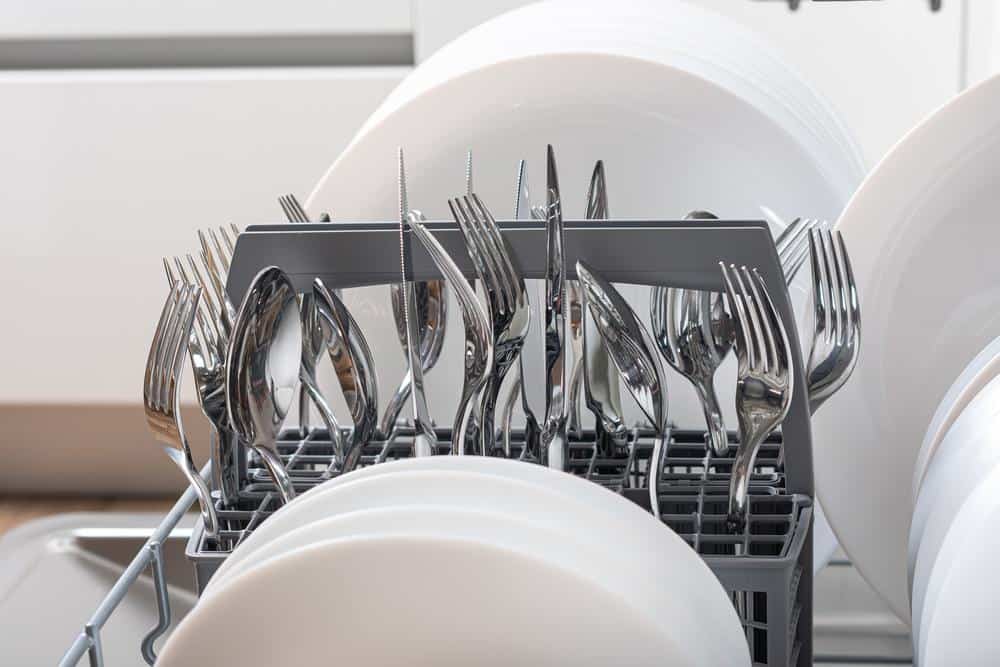
Cleaning your dishwasher may seem like an oxymoron, but it’s a crucial step in maintaining the longevity and efficiency of your appliance. Over time, food residues, grease, soap scum, and mineral deposits can accumulate inside your dishwasher, leading to unpleasant odors, poor cleaning performance, and potential damage to the appliance.
To wash a dishwasher, first remove and clean the filter under hot running water. Next, run a heavy cycle with a dishwasher-safe bowl filled with one cup of distilled white vinegar on the upper rack. Then, sprinkle a cup of baking soda on the bottom of the dishwasher and run a short cycle. Finally, wipe down the door, edges, seals, and exterior with a damp microfiber cloth and use a stainless steel cleaner for stainless steel exteriors.
Why Is It Important To Wash a Dishwasher?
Your dishwasher is tasked with cleaning your dishes, but it also needs some TLC to keep it functioning at its best. A dirty dishwasher can lead to:
- Inefficient cleaning: Buildup in your dishwasher can prevent it from cleaning dishes effectively. Food particles and other debris can redeposit on your dishes during cycles, leaving them less than sparkling.
- Unpleasant odors: Food particles can rot and create unpleasant smells. Regular cleaning can prevent this problem.
- Damage to the appliance: Over time, buildup can corrode the dishwasher’s components and lead to expensive repairs or even replacement.
Regular cleaning can help your dishwasher work better and last longer, saving you money and ensuring your dishes are always clean and ready to use.
How Often Should a Dishwasher Be Cleaned?
Ideally, you should clean your dishwasher every one to three months, depending on how often you use it. However, if you notice any signs of buildup or smell any unpleasant odors, it’s time to give your dishwasher a good cleaning.
Signs That Your Dishwasher Needs Cleaning
- Food remains on dishes after a cycle
- Dishes aren’t as shiny or clean as they used to be
- There’s an unpleasant smell coming from the dishwasher
- The dishwasher doesn’t drain completely
- You notice buildup on the interior surfaces of the dishwasher
Step-By-Step Guide To Cleaning a Dishwasher
Here’s a comprehensive guide on how to clean your dishwasher using common household items:
- Remove and clean the dishwasher filter: This is typically located under the bottom spray arm. Rinely it under hot running water and use a soft toothbrush to scrub the mesh screen and plastic frame. Replace the filter.
- Run a vinegar rinse: Place a dishwasher-safe bowl filled with one cup of distilled white vinegar on the upper rack. Run a heavy cycle without detergent or dishes.
- Run a baking soda rinse: After the vinegar cycle, sprinkle a cup of baking soda on the bottom of the dishwasher and run a short cycle.
- Clean the door and seals: Wipe down the door, edges and rubber seals with a damp microfiber cloth. Use a toothbrush for hard-to-reach spots.
- Clean the exterior: For stainless steel exteriors, use a stainless steel cleaner to prevent smudges and fingerprints.
By following these steps, you can keep your dishwasher in top shape, ensuring it cleans effectively and lasts for many years.
Common Mistakes To Avoid When Cleaning a Dishwasher
When cleaning your dishwasher, avoid these common mistakes:
- Not cleaning the filter regularly: The filter is one of the dirtiest parts of a dishwasher and needs regular cleaning to prevent clogs and smells.
- Using too much detergent: Excess suds can leave a residue in your dishwasher. Follow the manufacturer’s instructions for how much detergent to use.
- Using the wrong cleaner: Bleach and stainless steel do not mix. If your dishwasher has a stainless steel interior, avoid using bleach as it can damage and discolor the surface.
- Not cleaning the seals: The seals around the dishwasher door can harbor mold and mildew. Regularly wipe them down with a damp cloth and mild cleaner.
Conclusion
Regularly cleaning your dishwasher can improve its performance, extend its lifespan, and provide a more hygienic environment for your dishes. By following the steps and tips in this guide, you can ensure your dishwasher continues to operate efficiently and effectively.
Remember to consult your dishwasher’s manual for specific cleaning instructions and recommendations. If you encounter any major issues or malfunctions during cleaning, consider hiring a professional to avoid causing further damage. Regular maintenance and care can help keep your dishwasher — and your dishes — in top shape.
Frequently Asked Questions
Can I use apple cider vinegar instead of white vinegar for cleaning?
Yes, you can use apple cider vinegar as a substitute for white vinegar. It is equally effective in removing grease and mineral deposits. However, it might leave a slight smell which usually dissipates after a while.
What can I do if my dishwasher has a persistent bad smell even after cleaning?
If the smell persists after cleaning, it might be due to a clogged drain, a dirty filter, or trapped food particles. Make sure to clean these areas thoroughly. If the problem persists, you may need to call in a professional.
How can I remove hard water stains from my dishwasher?
You can remove hard water stains by running a cycle with a dishwasher cleaner designed to remove mineral build-up. Alternatively, you can use a home remedy of equal parts white vinegar and baking soda. Run a cycle with this mixture and it should help to remove the stains.
Can I use bleach to clean a plastic interior dishwasher?
Yes, if your dishwasher has a plastic interior, you can use a bleach solution to clean it. However, never use bleach in a dishwasher with a stainless steel interior as it can corrode and discolor the surface.
Is it safe to use a dishwasher cleaner?
Yes, it is safe to use a dishwasher cleaner. These products are specifically designed to clean dishwashers and are safe for both the appliance and your dishes. However, always follow the manufacturer’s instructions when using these products.











